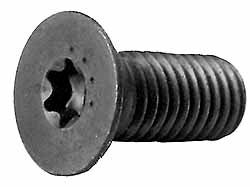The Torx Screw: Why You’ve Never Had it So Good
We may earn revenue from the products available on this page and participate in affiliate programs. Learn more › The...

We may earn revenue from the products available on this page and participate in affiliate programs. Learn more ›
The device that has raised gun nuts above the level of brutish beasts is not the Powerful Assault Rifle, or Very Low Drag bullets, or tactical scopes, or movies about snipers. It is the Torx screw. Before Torx, which appeared in 1967, all firearms relied on slothead screws, which were designed to make ordinary shooters miserable and enable gunsmiths to drive around in Bentleys.
The problem with the slothead screw is a phenomenon known as “cam-out.” When you put enough torque on it, the screwdriver blade cams up and out of the slot and skids across steel and walnut, usually resulting in gouges that require repolishing and rebluing or else sanding and refinishing.
Or, if your screwdriver didn’t cam up and out, its blade would tear or snap and you’d be left with a useless screwdriver. Or, the most common side effect, cheap, poorly fitting screwdrivers would mangle the slot in the screw head beyond use. Indeed, the best way to judge a used rifle in those days was to look at the screws. If they were “boogered,” as Bob Brister used to say, it was a good sign that some unskilled oaf had owned the gun, messed with it, and screwed it up, so to speak.
The only people who could use a slothead screwdriver without creating havoc were gunsmiths. It was a sign of their craft that they could twist a slothead with lots and lots of torque and never booger a screw. Part of this was practice; part was a high degree of manual dexterity. A big part was that all of them either made or custom ground their own screwdrivers, and before they began twisting the night away they made sure the blade fit the slot.
You could not enter a gunsmith’s domain without seeing screwdrivers made by Grace Metal Products. They were, and are, throwbacks to a more gracious age, with wood handles that give you a good grip and spring steel blades that are correctly ground. Any gunsmith worthy of the name would have a bushel or so, and would have custom-ground at least a half-dozen to suit his own fancy.
Real hard-core gunsmiths made their own screwdrivers. They did all the grinding and tempering and at the end they expected their tools to twist the head off a machine screw without breaking.
Some custom gunmakers made their own slothead screws with impossibly thin slots. It was their way of showing how good they were, and warning the unskilled clods who bought their work not to screw with what came out of their shops. European gunsmiths were especially fond of this; some even went to the trouble of filling their screw slots with gold so no one would ever get at them. And most high-grade British and European firearms had all their screws lined up north and south.
Back in my youth I was an inveterate and unskilled tinkerer, and constantly boogering screws and scratching stocks. I was also friends with the great engraver and stockmaker Winston G. Churchill, who lived an hour’s train ride from me. I had a couple of his rifles, and was constantly threating to work on them myself.
One day, I called him up and said: “Winnie, I just broke a screwdriver in the Immaculate Conception [which is what we called a particularly fancy rifle he had built]. There’s a gouge in the stock you could grow potatoes in. You better come over and look at it.”
By now, Churchill had accepted the fact that I was fundamentally dishonest and had taken enough of my nonsense. An hour later came a pounding at the door. I opened it and there was Winston, and I knew I was looking at Death.
“Give me your tools, all of them,” he hissed.
I did, and he took them without a word and left. He still has them. You don’t have fun like that with Torx screws.